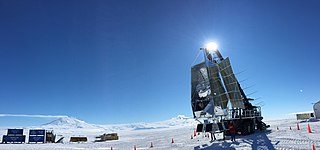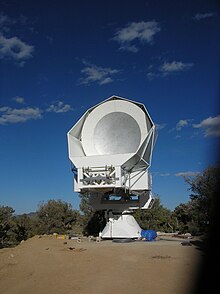The cosmic microwave background is microwave radiation that fills all space. It is a remnant that provides an important source of data on the primordial universe. With a standard optical telescope, the background space between stars and galaxies is almost completely dark. However, a sufficiently sensitive radio telescope detects a faint background glow that is almost uniform and is not associated with any star, galaxy, or other object. This glow is strongest in the microwave region of the radio spectrum. The accidental discovery of the CMB in 1965 by American radio astronomers Arno Penzias and Robert Wilson was the culmination of work initiated in the 1940s.

The Wilkinson Microwave Anisotropy Probe (WMAP), originally known as the Microwave Anisotropy Probe, was a NASA spacecraft operating from 2001 to 2010 which measured temperature differences across the sky in the cosmic microwave background (CMB) – the radiant heat remaining from the Big Bang. Headed by Professor Charles L. Bennett of Johns Hopkins University, the mission was developed in a joint partnership between the NASA Goddard Space Flight Center and Princeton University. The WMAP spacecraft was launched on 30 June 2001 from Florida. The WMAP mission succeeded the COBE space mission and was the second medium-class (MIDEX) spacecraft in the NASA Explorer program. In 2003, MAP was renamed WMAP in honor of cosmologist David Todd Wilkinson (1935–2002), who had been a member of the mission's science team. After nine years of operations, WMAP was switched off in 2010, following the launch of the more advanced Planck spacecraft by European Space Agency (ESA) in 2009.

The Cosmic Background Imager was a 13-element interferometer perched at an elevation of 5,080 metres at Llano de Chajnantor Observatory in the Chilean Andes. It started operations in 1999 to study the cosmic microwave background radiation and ran until 2008.
In physical cosmology, the inflationary epoch was the period in the evolution of the early universe when, according to inflation theory, the universe underwent an extremely rapid exponential expansion. This rapid expansion increased the linear dimensions of the early universe by a factor of at least 1026 (and possibly a much larger factor), and so increased its volume by a factor of at least 1078. Expansion by a factor of 1026 is equivalent to expanding an object 1 nanometer (10−9 m, about half the width of a molecule of DNA) in length to one approximately 10.6 light years (about 62 trillion miles) long.
Clover would have been an experiment to measure the polarization of the Cosmic Microwave Background. It was approved for funding in late 2004, with the aim of having the full telescope operational by 2009. The project was jointly run by Cardiff University, Oxford University, the Cavendish Astrophysics Group and the University of Manchester.

Owens Valley Radio Observatory (OVRO) is a radio astronomy observatory located near Big Pine, California (US) in Owens Valley. It lies east of the Sierra Nevada, approximately 350 kilometers (220 mi) north of Los Angeles and 20 kilometers (12 mi) southeast of Bishop. It was established in 1956, and is owned and operated by the California Institute of Technology (Caltech). The Owens Valley Solar Array portion of the observatory has been operated by New Jersey Institute of Technology (NJIT) since 1997.

The South Pole Telescope (SPT) is a 10-metre (390 in) diameter telescope located at the Amundsen–Scott South Pole Station, Antarctica. The telescope is designed for observations in the microwave, millimeter-wave, and submillimeter-wave regions of the electromagnetic spectrum, with the particular design goal of measuring the faint, diffuse emission from the cosmic microwave background (CMB). The first major survey with the SPT—designed to find distant, massive, clusters of galaxies through their interaction with the CMB, with the goal of constraining the dark energy equation of state—was completed in October 2011. In early 2012, a new camera (SPTpol) was installed on the SPT with even greater sensitivity and the capability to measure the polarization of incoming light. This camera operated from 2012–2016 and was used to make unprecedentedly deep high-resolution maps of hundreds of square degrees of the Southern sky. In 2017, the third-generation camera SPT-3G was installed on the telescope, providing nearly an order-of-magnitude increase in mapping speed over SPTpol.

The Atacama Cosmology Telescope (ACT) is a cosmological millimeter-wave telescope located on Cerro Toco in the Atacama Desert in the north of Chile. ACT makes high-sensitivity, arcminute resolution, microwave-wavelength surveys of the sky in order to study the cosmic microwave background radiation (CMB), the relic radiation left by the Big Bang process. Located 40 km from San Pedro de Atacama, at an altitude of 5,190 metres (17,030 ft), it is one of the highest ground-based telescopes in the world.

Llano de Chajnantor Observatory is the name for a group of astronomical observatories located at an altitude of over 4,800 m (15,700 ft) in the Atacama Desert of northern Chile. The site is in the Antofagasta Region approximately 50 kilometres (31 mi) east of the town of San Pedro de Atacama. The exceptionally arid climate of the area is inhospitable to humans, but creates an excellent location for millimeter, submillimeter, and mid-infrared astronomy. This is because water vapour absorbs and attenuates submillimetre radiation. Llano de Chajnantor is home to the largest and most expensive astronomical telescope project in the world, the Atacama Large Millimeter Array (ALMA). Llano de Chajnantor and the surrounding area has been designated as the Chajnantor Science Reserve by the government of Chile.
The Degree Angular Scale Interferometer (DASI) was a telescope installed at the U.S. National Science Foundation's Amundsen–Scott South Pole Station in Antarctica. It was a 13-element interferometer operating between 26 and 36 GHz in ten bands. The instrument is similar in design to the Cosmic Background Imager (CBI) and the Very Small Array (VSA). In 2001 The DASI team announced the most detailed measurements of the temperature, or power spectrum of the Cosmic microwave background (CMB). These results contained the first detection of the 2nd and 3rd acoustic peaks in the CMB, which were important evidence for inflation theory. This announcement was done in conjunction with the BOOMERanG and MAXIMA experiment. In 2002 the team reported the first detection of polarization anisotropies in the CMB.

Spider is a balloon-borne experiment designed to search for primordial gravitational waves imprinted on the cosmic microwave background (CMB). Measuring the strength of this signal puts limits on inflationary theory.

QUIET was an astronomy experiment to study the polarization of the cosmic microwave background radiation. QUIET stands for Q/U Imaging ExperimenT. The Q/U in the name refers to the ability of the telescope to measure the Q and U Stokes parameters simultaneously. QUIET was located at an elevation of 5,080 metres at Llano de Chajnantor Observatory in the Chilean Andes. It began observing in late 2008 and finished observing in December 2010.

BICEP and the Keck Array are a series of cosmic microwave background (CMB) experiments. They aim to measure the polarization of the CMB; in particular, measuring the B-mode of the CMB. The experiments have had five generations of instrumentation, consisting of BICEP1, BICEP2, the Keck Array, BICEP3, and the BICEP Array. The Keck Array started observations in 2012 and BICEP3 has been fully operational since May 2016, with the BICEP Array beginning installation in 2017/18.

The Cosmology Large Angular Scale Surveyor (CLASS) is an array of microwave telescopes at a high-altitude site in the Atacama Desert of Chile as part of the Parque Astronómico de Atacama. The CLASS experiment aims to improve our understanding of cosmic dawn when the first stars turned on, test the theory of cosmic inflation, and distinguish between inflationary models of the very early universe by making precise measurements of the polarization of the Cosmic Microwave Background (CMB) over 65% of the sky at multiple frequencies in the microwave region of the electromagnetic spectrum.
John Michael Kovac is an American physicist and astronomer. His cosmology research, conducted at the Center for Astrophysics | Harvard & Smithsonian in Cambridge, Massachusetts, focuses on observations of the Cosmic Microwave Background (CMB) to reveal signatures of the physics that drove the birth of the universe, the creation of its structure, and its present-day expansion. Currently, Kovac is Professor of Astronomy and Physics at Harvard University.

The Atacama B-Mode Search (ABS) was an experiment to test the theory of cosmic inflation and distinguish between inflationary models of the very early universe by making precise measurements of the polarization of the Cosmic Microwave Background (CMB). ABS was located at a high-altitude site in the Atacama Desert of Chile as part of the Parque Astronómico de Atacama. ABS began observations in February 2012 and completed observations in October 2014.

Brian Gregory Keating is an American cosmologist. He works on observations of the cosmic microwave background, leading the BICEP, POLARBEAR2 and Simons Array experiments. He received his PhD in 2000, and is a Distinguished Professor of Physics at University of California, San Diego since 2019. He is the author of two books, Losing The Nobel Prize and Into the Impossible.

The Simons Observatory is located in the high Atacama Desert in Northern Chile inside the Chajnator Science Preserve, at an altitude of 5,200 meters (17,000 ft). The Atacama Cosmology Telescope (ACT) and the Simons Array are located nearby and these experiments are currently making observations of the Cosmic Microwave Background (CMB). Their goals are to study how the universe began, what it is made of, and how it evolved to its current state. The Simons Observatory shares many of the same goals but aims to take advantage of advances in technology to make far more precise and diverse measurements. In addition, it is envisaged that many aspects of the Simons Observatory will be pathfinders for the future CMB-S4 array.
LiteBIRD is a planned small space observatory that aims to detect the footprint of the primordial gravitational wave on the cosmic microwave background (CMB) in a form of polarization pattern called B-mode.














